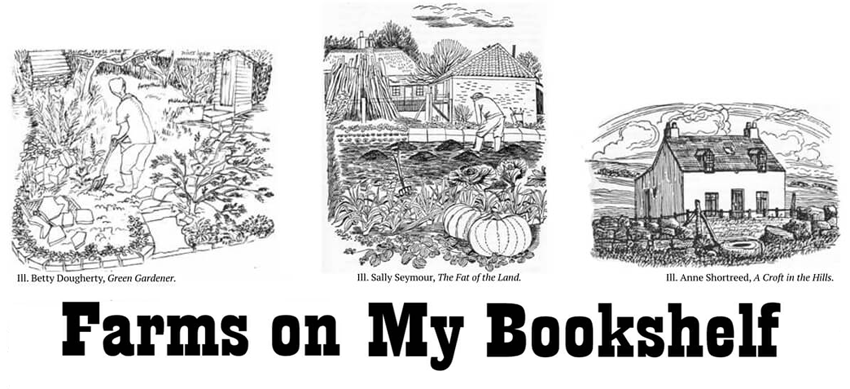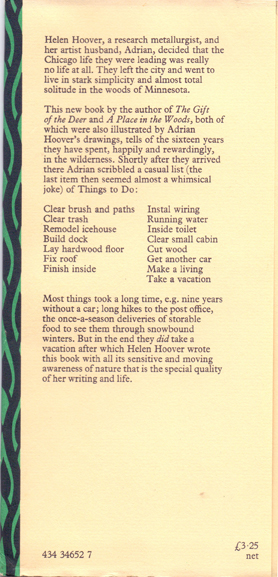This book was published five years after "A Place in the Woods" and it covers the 16 years Helen and Adrian Hoover spent in their cabin on Gunflint Lake, on the Canadian border in Minnesota. While the text on the book flap states that they spent those years happily and rewardingly this was not alway so and the book ends with their leaving the area.
On the one hand this is the story of how Helen and Adrian make the cabin their home and how they cope with living in northern Minnesota, with its harsh climate. On the other it is a record of the nature that surrounds them and the animals that come to visit.
As we learned in Helen's earlier book, living in the woods in hard work. Even in spring or summer things don't get much easier: "the mosquitos and black flies were out in full force, ready for their coming task of fertilizing the flowers, and they bit so ferociously that we gave up on outdoor work." They don't hunt or fish and the very short summer season makes it very difficult to grow vegetables. They do keep a few chickens (in a heated run in winter). But mostly they depend on mail order and deliveries of food and oil. Missing an oil truck delivery, or being snowed in with little food, are potential disasters. Their first years in the cabin are very hard, as they struggle to pay their bills. They earn just enough money selling notepaper printed with Adrian's designs and they live on such an unbalanced diet that at one time Helen even suffers from scurvy.

"Ade and I had come to the forest believing that we would have to work harder than we had ever worked and thinking the depression years had prepared us, but we discovered they had been relatively easy. We had been poor in the sense of having to cut corners during our first year and a half in the woods. Two years later we were poverty stricken - cold, hungry, ragged, sick and touched by flashes of paralyzing terror. This was not the fear of death but the fear of living, of never having some small pleasure or physical comfort of a moment free of worry so long as life should last. (...) And yet I warmed to the happy moments we were finding in this innocent forest. The wild creatures were our friends and companions, our teachers, our entertainers ..."
Gradually Helen starts to earn some money when she sells magazine articles and the hard years are over when she gets her first book contract.
"
When the book was roughed out, I roamed the forest, burdened with two field guides that I carried around my neck in a two-pound clothespin bag, checking my reported observations for accuracy. (...) When I grew tired I sat at the base of a big pine or spruce, leaned back, and closed my eyes. My skin grew sensitive to the touch of the special air of spring, the drier air of summer. Faint creakings told me of branches rubbing together. One day my nose crinkled to an acrid scent, something like rancid oil, and I opened my eyes to see a black bear strolling toward me. I sat without moving while he came almost to my resting place, observed me with shifting eyes as I was observing him, sniffed and wandered away, presumably no longer curious."Later in the book there a more encounters with (hungry) bears and one winter things become so dangerous, as bears could easily smash their doors and windows, that they go and spend some time in a motel.
While they still encounter a lot of kindness, they are also seen as weirdos, living without a car and refusing to have a power line put in (because it would mean cutting down lots of trees). They also refuse to cut down trees or use DDT during an infestion of budworms that takes a few years. In the end their policy of letting nature take care of itself pays off.
A lot of animals, especially deer, come to the cabin in winter, in search of food. They order food for animals but word gets round and this attract hunters, and some of the deer that have been visiting them for years are killed.
With the extra money they earn they do up their cabin and they can afford a few more luxuries, but things start to change: the road is repaired, more tourists come, the solitude they cherished is gone and they begin to feel uncomfortable where once they were so happy.
"Power, phone and road together attracted more and more people, which meant more and more building. This necessitated clearing, which increased run-off water and silting of the lakes, and the installation of many cesspools that released an effluent that stimulated algae growth in the clear water, as the privies of the old days had not done. More planes and boats to accommodate the larger number of people added their oil films to the lake."
In the end they take a vacation, the last item on their list (see book flap below), and start looking for another place to live.
If you would like to read more about Helen Hoover, a very good article by David Hakense can be found here





